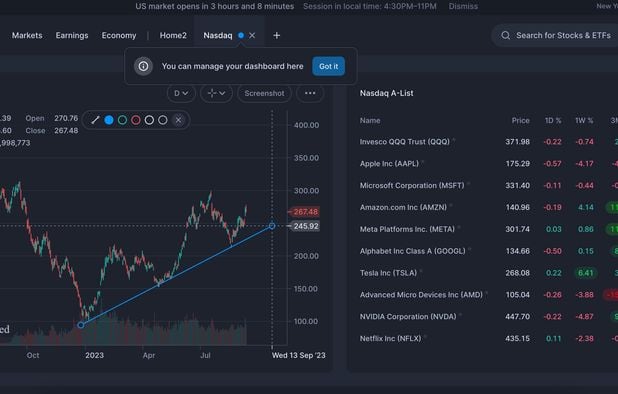To get precise information, accurate and reliable it is essential to check the AI models and machine learning (ML). Incorrectly designed models or those that oversell themselves can result in faulty forecasts as well as financial loss. Here are 10 best ways to evaluate the AI/ML platform of these platforms.
1. Understanding the model's purpose and approach
Clear objective: Determine whether the model was designed to be used for trading in the short term, long-term investment, sentiment analysis or risk management.
Algorithm disclosure: Determine if the platform discloses which algorithms it employs (e.g. neural networks or reinforcement learning).
Customization. Find out whether the model can be adapted to be modified according to your trading strategy or level of risk tolerance.
2. Evaluation of Performance Metrics for Models
Accuracy: Test the accuracy of the model in forecasting the future. However, do not solely rely on this metric because it could be inaccurate when applied to financial markets.
Accuracy and recall: Examine how well the model identifies true positives (e.g. accurately forecasted price changes) and eliminates false positives.
Risk-adjusted returns: Determine if the model's predictions lead to profitable trades after accounting for the risk (e.g., Sharpe ratio, Sortino ratio).
3. Make sure you test the model using Backtesting
Historical performance: Use previous data to test the model and determine how it would have performed under the conditions of the market in the past.
Testing on data other than the sample is crucial to prevent overfitting.
Scenario analysis: Assess the model's performance in various market conditions.
4. Make sure you check for overfitting
Overfitting signs: Look out for models that do exceptionally well on training data however, they perform poorly with unobserved data.
Regularization methods: Ensure that the platform doesn't overfit when using regularization methods such as L1/L2 or dropout.
Cross-validation (cross-validation): Make sure the platform is using cross-validation to assess the generalizability of the model.
5. Examine Feature Engineering
Important features: Make sure that the model has relevant attributes (e.g. price or volume, as well as technical indicators).
Feature selection: You should ensure that the platform is choosing features with statistical significance and avoid redundant or unneeded information.
Updates to dynamic features: Make sure your model is updated to reflect recent characteristics and current market conditions.
6. Evaluate Model Explainability
Interpretability - Make sure that the model provides explanations (e.g. value of SHAP and the importance of features) to support its claims.
Black-box platforms: Beware of platforms that utilize too complex models (e.g. neural networks that are deep) without explainingability tools.
User-friendly insights: Make sure that the platform provides actionable insights in a form that traders can comprehend and use.
7. Examine the flexibility of your model
Market shifts: Determine whether your model is able to adapt to market fluctuations (e.g. new regulations, economic shifts or black-swan events).
Make sure that the model is continuously learning. The platform should be updated the model often with new information.
Feedback loops - Make sure that the platform incorporates real-world feedback from users and feedback from the user to enhance the model.
8. Check for Bias & Fairness
Data biases: Ensure that the training data are accurate and free of biases.
Model bias: Verify whether the platform is actively monitoring the biases in the model's prediction and if it mitigates them.
Fairness. Make sure your model doesn't unfairly favor certain stocks, industries or trading strategies.
9. Assess the computational efficiency
Speed: Check if the model can generate predictions in real time or with minimal latency, especially in high-frequency trading.
Scalability: Determine whether a platform is able to handle multiple users and large databases without affecting performance.
Resource usage : Determine if the model has been optimized to use computational resources effectively (e.g. GPU/TPU).
10. Review Transparency and Accountability
Model documentation: Ensure the platform provides an extensive document detailing the model's architecture and training process.
Third-party Audits: Check whether the model was independently audited or validated by third organizations.
Error handling: Check that the platform has mechanisms to identify and correct mistakes or errors in the model.
Bonus Tips
User reviews and Case studies Review feedback from users and case studies in order to evaluate the actual performance.
Free trial period: Try the model's accuracy and predictability by using a demo or a free trial.
Customer support - Make sure that the platform you choose to use is able to offer a solid support service to solve technical or model related issues.
By following these tips you can assess the AI/ML models of platforms for stock prediction and make sure that they are precise transparent and aligned to your trading objectives. Follow the best best ai trading software recommendations for site recommendations including investing ai, ai trade, chatgpt copyright, ai investing app, market ai, ai investment app, chart ai trading assistant, best AI stock, ai investing, AI stock trading bot free and more.

Top 10 Tips On Risk Management Of Ai Trading Platforms That Can Predict Or Analyze The Price Of Stocks.
Any AI platform for analyzing or predicting stocks must include risk management, which is essential to safeguard your capital and limiting losses. Platforms with robust risk management tools will help you navigate the volatile stock markets and make the right decision. Here are the top 10 ways to evaluate the risk management capabilities of these platforms: capabilities:
1. Evaluation of Stop-Loss and Take-Profit Features
Customizable settings: Make sure you can set the take-profit or stop-loss level for certain trades.
Make sure the platform is able to allow the use of trailing stops. They automatically adjust themselves as market moves in your favor.
If the platform offers stop-loss order guarantees that your trade is closed at the price specified in volatile markets and you are assured that you will be able to trade successfully.
2. Calculate the Size of Position Tools
Fixed amount: Make sure the platform permits you to determine the size of your position based on a fixed monetary amount.
Percentage in your portfolio: You can manage your risk by setting positions sizes in proportion to a percentage.
Risk-reward rate: Check to see if it is possible to determine the risk-reward ratio for specific strategies or trades.
3. Look for Diversification Support
Multi-asset Trading For diversification of your portfolio of investments, be sure that the trading platform you select allows trading across multiple asset classes.
Sector allocation: Determine whether the platform has tools for monitoring and managing exposure to sectors.
Diversification of geographical areas - Make sure that the platform supports trading on international markets. This can help spread geographical risks.
4. Evaluating margin and leverage controls
Margin requirement: Verify that the platform is clear about any margin requirements for leveraged trades.
Find out whether you can establish leverage limits in order to limit the risk you take.
Margin call - Check to see if your service alerts you to margin calls in a timely manner. This will help prevent liquidation.
5. Review Risk Analytics Reporting
Risk metrics. Make sure your platform has key risk indicators (e.g. VaR Sharpe Ratio) relevant to your portfolio.
Scenario assessment: Find out whether you can simulate various scenarios of markets on the platform to evaluate potential risks.
Performance reports: Find out if you can get detailed performance reports from the platform, including the risk-adjusted outcomes.
6. Check for Real-Time Risk Monitoring
Monitoring of portfolios - Make sure that the platform you choose offers real-time monitoring to ensure your portfolio is safe.
Alerts and notifications - Check that the platform has sent out alerts in real-time when certain risk-related events occur (e.g. margin breaches and triggers for stop-loss orders).
Review the risk dashboards. If you wish to have a comprehensive view of your risks, be sure that they are customizable.
7. Test Stress Testing and backtesting
Stress testing: Ensure that the platform you use allows you to test your strategies or portfolio in extreme market conditions.
Backtesting - See whether your platform permits you to backtest strategies with old data. This is a great way to measure risk and assess the effectiveness of your strategy.
Monte Carlo Simulators: Verify whether the platform utilizes Monte Carlo models to model possible outcomes and evaluate risks.
8. Verify Compliance with Risk Management Regulations
Compliance with the regulatory requirements: Ensure your platform is in compliance with the applicable risk management regulations in Europe as well as the U.S. (e.g. MiFID II).
The best execution: Make sure that the platform adheres with the most efficient execution methods. Trades will be executed at the most affordable price possible to minimize loss.
Transparency. Check that the platform is clear and clear about risks.
9. Examine for Risks that are User Controlled Parameters
Custom risk rules: Ensure that the platform you choose allows you to create custom risk management rules.
Automated risks controls: Verify whether the system can automatically apply rules to manage risk based on your defined parameters.
Manual overrides Check whether you are able to manually override the risk control system that is automated in a situation of emergency.
Review Case Studies, User Feedback, and Case Studies
Review by users: Conduct research to determine the platform's efficiency in risk management.
Testimonials and case studies The case studies and testimonials will demonstrate the capabilities of the platform for managing risk.
Community forums: Find out whether a platform is home to a community of users who are willing to share their strategies and tips to manage the risk.
Bonus Tips:
Trial period: Use an unpaid trial or demo to test the platform's risk management features in real-world situations.
Customer Support: Verify that the platform is able to provide a comprehensive customer support solution for any risk management related concerns or questions.
Educational resources - See whether the platform provides educational resources and tutorials about best practices in risk management.
Check out these suggestions to determine the risk-management abilities of AI trading platforms that predict/analyze the prices of stocks. Select a platform that has a high quality of risk-management and you will limit your losses. Effective risk management tools are essential for navigating volatile markets and achieving long-term trading success. Check out the recommended their explanation for website recommendations including best ai for stock trading, can ai predict stock market, stock trading ai, ai trading tool, invest ai, ai share trading, chart ai trading, how to use ai for stock trading, AI stock prediction, AI stock analysis and more.
